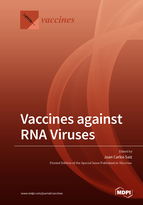Vaccines against RNA Viruses
A special issue of Vaccines (ISSN 2076-393X).
Deadline for manuscript submissions: closed (31 December 2019) | Viewed by 47768
Special Issue Editor
Interests: RNA viruses; Flavivirus; host-cell interactions; surveillance and prevention (diagnosis, epidemiology, vaccines and antivirals)
Special Issues, Collections and Topics in MDPI journals
Special Issue Information
Dear Colleagues,
As the Guest Editor of the Vaccines Special Issue “Vaccines against RNA Viruses” (https://www.mdpi.com/journal/vaccines/special_issues), I would like to invite you to contribute with an original report, original observation, or review to it.
As you are perfectly aware, RNA viruses cause many animal, human, and zoonotic diseases, affecting millions of individuals. In this regard, vaccines have had an enormous impact on overcoming the global burden of diseases. However, and although efficient vaccines are available for some RNA viruses, in many instances and for different reasons (technologic restrictions, economic facts, etc.), they are scarcely used in the field, and, even more, for many of them, no licensed vaccines are available. Therefore, as the world remains burdened by high morbidity and mortality diseases and new emerging or re-emerging pathogens are likely to spread in the future, to achieve a more comprehensive understanding of the current trends in vaccines development and assessment, this Vaccines Special Issue is dedicated to recent search for efficient vaccines, focusing on the scientific and technical progress made in the field of vaccines targeting RNA viruses, as well as in understanding the molecular mechanisms and immune responses involved. Based on your extensive experience and your recent publications, it will be our honor to publish your quality work to support the global scientific community. We sincerely hope that you will be able to accept our invitation. If you are able to contribute, please let us know at your earliest convenience and we will provide you with additional details.
Vaccines (https://www.mdpi.com/journal/vaccines) is an online open access journal covering vaccine-related sciences, indexed in the Science Citation Index Expanded (SCIE) and BIOSIS Previews in Web of Science and in Scopus. Citations available in PubMed, full-text archived in PubMed Central. CiteScore 2018 (Scopus): 5.43, which equals rank 12/272 (Q1) in the category 'Infectious Diseases', 31/198 (Q1) in 'Immunology', and 4/232 (Q1) in 'Pharmacology (medical)'. Manuscripts are peer-reviewed and a first decision provided to authors approximately 17.7 days after submission; acceptance to publication is undertaken in 4.4 days (median values for papers published in this journal in the second half of 2018), assuring rapid publication.
Sincerely
Prof. Dr. Juan Carlos Saiz
Guest Editors
Manuscript Submission Information
Manuscripts should be submitted online at www.mdpi.com by registering and logging in to this website. Once you are registered, click here to go to the submission form. Manuscripts can be submitted until the deadline. All submissions that pass pre-check are peer-reviewed. Accepted papers will be published continuously in the journal (as soon as accepted) and will be listed together on the special issue website. Research articles, review articles as well as short communications are invited. For planned papers, a title and short abstract (about 100 words) can be sent to the Editorial Office for announcement on this website.
Submitted manuscripts should not have been published previously, nor be under consideration for publication elsewhere (except conference proceedings papers). All manuscripts are thoroughly refereed through a single-blind peer-review process. A guide for authors and other relevant information for submission of manuscripts is available on the Instructions for Authors page. Vaccines is an international peer-reviewed open access monthly journal published by MDPI.
Please visit the Instructions for Authors page before submitting a manuscript. The Article Processing Charge (APC) for publication in this open access journal is 2700 CHF (Swiss Francs). Submitted papers should be well formatted and use good English. Authors may use MDPI's English editing service prior to publication or during author revisions.
Keywords
- human vaccines
- veterinary vaccines
- zoonotic virus vaccines
- vaccine platforms
- animal models
- immune responses
- effectiveness
- trials
- maternal immunization
- public health considerations







